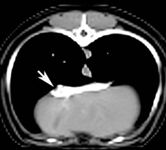Surgery STAT
Congenital portosystemic shunts (PSS) occur in 0.18 percent of all dogs, and are particularly common in Yorkshire Terriers, Maltese dogs, Pugs, Schnauzers and Shih Tzus.
Congenital portosystemic shunts (PSS) occur in 0.18 percent of all dogs, and are particularly common in Yorkshire Terriers, Maltese dogs, Pugs, Schnauzers and Shih Tzus.
Heredity is considered an underlying cause in at least 33 breeds, with the pattern of inheritance suggestive of an autosomal dominant trait with incomplete penetrance. Clinical signs suggestive of congenital shunts include poor growth, lethargy, behavioral changes, ataxia or seizures in a young dog from a predisposed breed (Photo 1).

Some dogs may present with only urinary-tract signs, and a small percentage may be clinically normal. Although basic laboratory tests are not definitively diagnostic of a congenital PSS, results may increase the suspicion for this condition.
Complete blood counts in dogs with congenital PSS frequently have microcytosis. Anemia, if present, is usually mild and non-regenerative. Biochemi-stry profiles often reveal decreased blood urea nitrogen and albumin due to decreased production. Total protein may be normal if globulins are increased. Increases in liver enzymes ALT and AST are variable.
Because cholestasis is not a feature of congenital PSS, increases in alkaline phosphatase are more likely the result of bone growth, and bilirubin concentrations should be normal. Hypoglycemia is common in toy breeds with congenital PSS; however, toy-breed or puppy hypoglycemia is a differential for ataxia and seizures. Because urine concentration is dependent on urea production, dogs with congenital PSS may have decreased urine specific gravity. They are predisposed to urinary-tract infections because of irritation from ammonium biurate crystalluria or urate stones.

Photo 1: Affected dogs often are underweight, have poor hair coats and manifest behavioral changes.
Increases in bile acids and ammonia are highly suggestive of liver disease, but the diagnosis of PSS cannot be based solely on these findings. Feeding meals high in fat will stimulate gallbladder contraction and subsequent increase in bile acids, with the peak increase occurring around two hours after the meal. About 20 percent of dogs may have spontaneous gallbladder contractions, resulting in "fasting" samples actually being higher than "fed" samples. Therefore, obtaining both samples is recommended.
Although all dogs with congenital PSS have increased fasting or fed bile acids, the increase can be very small. Winkler et al. reported six dogs with congenital PSS that had fasting and fed bile acids of 25 mcg/dL or less. Also, urine bile acids, when compared to urine-creatinine concentrations, have been evaluated for diagnosis of congenital PSS but can give false negatives in 26 percent to 33 percent of affected dogs.

Photo 2: Single extrahepatic gastrophrenic shunt. The shunt crosses from the dog's left to right along the liver and diaphragm before draining into the caudal vena cava (arrow).
Ammonia concentrations are increased in most affected dogs six hours after feeding. Use of an ammonia tolerance test will increase sensitivity.
Because conditions such as congenital portal hypoplasia (hepatic microvascular dysplasia), multiple acquired PSS, epilepsy and other liver diseases can present with similar clinical signs or even lab abnormalities, definitive diagnosis of congenital portosystemic shunts will need to be based on advanced imaging techniques such as ultrasound, trans-splenic scintigraphy, portography or CT (Photo 2).
Dr. Tobias is an ACVS board-certified surgeon who specializes in small-animal soft-tissue surgery. Her primary research interest is congenital portosystemic shunts in dogs. Dr. Tobias is a full professor at the University of Tennessee and lives in Knoxville with her husband, two children and a multitude of unmanageable pets.
To locate a Diplomate, ACVS has an on-line directory, which includes practice setting, species emphasis and research interests ( www.acvs.org/VeterinaryProfessionals/FindaSurgeon).
EDITOR'S NOTE: SurgerySTAT, a collaborative column with the American College of Veterinary Surgeons (ACVS) and DVM Newsmagazine, debuted last month. This month, a three-part series begins on congenital portosystemic shunts (PSS). Many veterinarians suspect a PSS based on history, signalment and results of basic laboratory tests. This series will provide information on interpretation of these test results and potential differential diagnoses; supportive care and prognosis with medical management alone; and surgical options, postoperative care and outcome/prognosis associated with surgery.